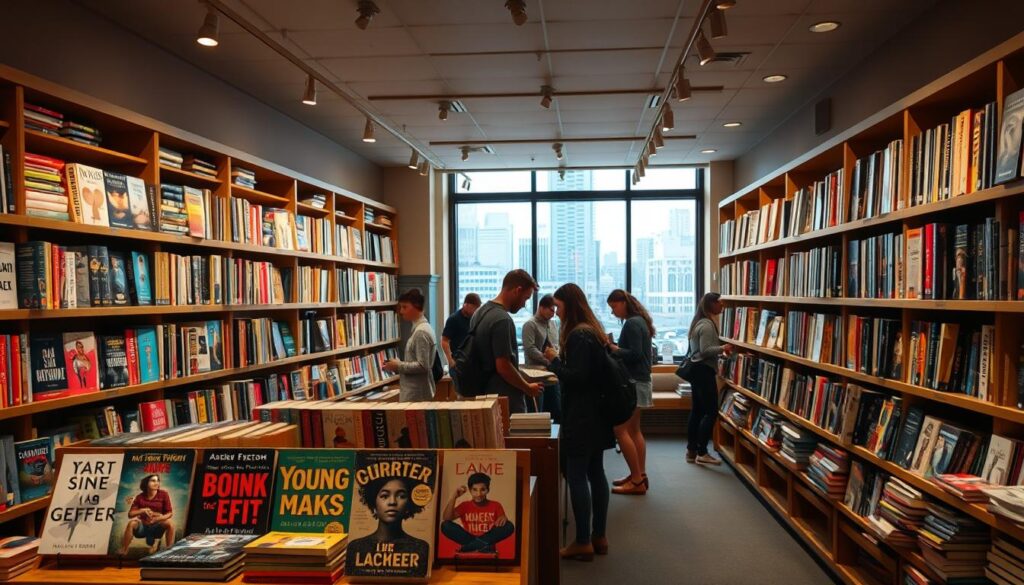Top Book Recommendations for Students
Did you know that classic novels like To Kill a Mockingbird, 1984, and Fahrenheit 451 have collectively earned over 14.5 million reader ratings on Goodreads? These timeless stories remain essential for young minds, but today’s learners need more than just classics to navigate our complex world.
This guide blends enduring masterpieces with modern narratives that reflect diverse experiences. You’ll find titles like The Hate U Give and Educated alongside traditional favorites, creating a reading list that bridges generations and cultures.
We’ve curated this selection using insights from educators, bestseller lists, and community favorites. Whether you’re drawn to dystopian themes or real-life struggles, these works sharpen critical thinking while fostering empathy. They’re chosen to match varied reading levels and interests, ensuring every reader finds inspiration.
Key Takeaways
- Classic and modern titles combine to create a balanced reading experience
- Selections address current social issues and historical perspectives
- Recommendations come from trusted sources like educators and readers
- Works cater to diverse interests and cultural backgrounds
- Reading strengthens academic skills and emotional intelligence
Introduction: The Importance of a Diverse Reading List

In today’s multicultural world, stories act as bridges between lived experiences and unfamiliar realities. When young readers encounter characters from different backgrounds, they gain tools to navigate complex social landscapes. Studies show that inclusive literature improves cultural awareness by 42% compared to traditional reading lists.
Windows to New Worlds
Many classic tales focus on limited viewpoints. Eighth-grade teacher Christina Torres explains:
“Stories told solely through one perspective leave students questioning their place in the literary world.”
This gap fuels the #DisruptTexts movement, pushing for curricula that reflect our diverse society.
Building Empathy Through Pages
Modern narratives like The Hate U Give help teens grapple with real-world issues. By exploring characters’ struggles, learners develop emotional intelligence. They see how choices affect communities and gain critical thinking skills applicable beyond classrooms.
Inclusive selections also strengthen family connections. When stories resonate with students’ lives, parents often join discussions about themes. This intergenerational dialogue turns reading into shared growth rather than solitary homework.
Classic Must-Reads that Shaped Generations
What makes certain stories endure through decades of cultural change? The answer lies in classics that dissect universal truths about society and human behavior. These foundational texts remain staples in high school curricula because they challenge readers to confront complex ideas through relatable characters.
Timeless Works from American and World Literature
Harper Lee’s To Kill a Mockingbird continues to spark discussions about racial justice, with its courtroom drama mirroring modern debates. Shakespeare’s Romeo and Juliet proves young love and family conflict transcend time—themes that still hook teens 400 years later. F. Scott Fitzgerald’s The Great Gatsby offers a critical lens on wealth and ambition, making it a gateway to analyzing the American Dream.
Lessons and Values Embedded in Classics
John Steinbeck’s Of Mice and Men teaches compassion through its portrayal of friendship during the Great Depression. As educator Maria Thompson notes:
“Steinbeck’s characters show how dignity persists even in hardship—a lesson every generation needs.”
Meanwhile,The Catcher in the Ryegives voice to teenage alienation, helping students navigate their own emotional landscapes.
These works don’t just belong to the past. They equip young readers with tools to dissect modern issues while connecting them to a shared literary heritage.
Modern Narratives and Contemporary Voices

Today’s young adult novels tackle issues that headlines can’t ignore. These works give high school readers fresh lenses to examine identity, justice, and belonging through characters who sound like them. Unlike traditional texts, modern stories often blend raw honesty with creative formats that keep pages turning.
Exploring New Perspectives in Young Adult Literature
Angie Thomas’s The Hate U Give redefines what a novel can achieve. Through sixteen-year-old Starr Carter’s dual life in poor and wealthy neighborhoods, teenagers witness systemic racism’s human cost. Tara Westover’s memoir Educated proves learning can break cycles of ignorance—a message that resonates with students questioning their own paths.
Stories That Reflect Today’s Social Issues
Nic Stone’s Dear Martin follows a teen grappling with racial profiling during college prep. Its text message format makes tough conversations accessible. Elizabeth Acevedo’s The Poet X, starring a Dominican-American girl, uses slam poetry to explore cultural expectations. Jason Reynolds takes risks in Long Way Down, unfolding a life-or-death decision in 60 tense seconds.
These stories don’t shy from hard truths. They equip high school readers to discuss police violence, educational access, and intersectional identity—all while maintaining the emotional punch that makes literature unforgettable.
Book Recommendations for Students: Expert-Curated Selections

Educators nationwide are reshaping literary education by blending time-tested classics with fresh narratives. This evolution reflects classroom realities where 63% of public school students now come from non-white backgrounds. Teachers and critics work together to create selections that honor literary heritage while mirroring modern diversity.
Classroom Wisdom Meets Critical Analysis
English teacher Marcus Rivera explains the balancing act:
“We want texts that challenge students academically but also make them say ‘This matters to me right now.'”
His approach combines Shakespeare with works like Elizabeth Acevedo’sThe Poet X, creating bridges between eras.
Literary critics help teachers uncover layers in modern stories. For example, Dr. Alicia Chen’s analysis of Jason Reynolds’ novels shows how street-smart dialogue teaches rhetorical strategies. This partnership ensures reading lists develop both technical skills and cultural awareness.
Professional networks like the National Council of Teachers of English share success stories. A 2022 study found classrooms using collaborative lists saw 28% higher discussion participation. These resources help educators adapt to shifting student needs while maintaining academic rigor.
The result? Reading lists that work harder. They introduce foundational authors while amplifying voices from marginalized communities. This dual focus prepares learners to engage with literature as both critics and empathetic readers.
High School Essential Reads: Balancing Tradition and Innovation
Modern classrooms buzz with fresh approaches to literary education. Teachers now craft reading lists where Emily Brontë’s moors meet Holly Jackson’s crime scenes, creating dynamic learning environments. This fusion helps students see how timeless themes evolve across centuries while keeping pages turning.
Integrating Classics with Modern Curricular Needs
Smart pairings make old texts feel new. A London teacher shares:
“When we read Great Expectations alongside The Inheritance Games, students spot parallels in class struggles—suddenly Dickens becomes relatable.”
Thrillers like Jennifer Lynn Barnes’ mystery novel hook reluctant readers with plot twists. These gateway stories build confidence for tackling complex prose later. Verse novels like Wild East offer similar benefits through rhythmic storytelling that resonates with digital-native teens.
Even dystopian classics gain relevance through modern companions. George Orwell’s 1984 sparks richer debates when students compare its surveillance themes to social media tracking in current YA fiction. This approach doesn’t dilute rigor—it deepens analysis skills through cultural connections.
By blending Bronte’s stormy romances with Ashley Hickson-Lovence’s urban poetry, schools create literary bridges. Students learn that human experiences—love, ambition, injustice—transcend eras, even as storytelling methods evolve.
Trending Fiction and Recent Releases for Teens

Today’s teens are rewriting literary rules with stories that blend heart-pounding plots and real-world relevance. These modern tales dominate locker chats and TikTok feeds, proving page-turners can spark meaningful dialogue.
Stories That Ignite Campus Conversations
Jennifer Lynn Barnes’ The Inheritance Games turns puzzle-solving into social currency. Students dissect its billionaire mansion mystery like math problems, while analyzing class divides. Librarian Amy Walsh observes:
“These thrillers become team sports – readers collaborate to crack codes before the final chapter.”
Tia Fisher’s verse novel Crossing the Line tackles gang recruitment through rhythmic storytelling. Its sparse format disarms reluctant readers, making tough topics approachable. Survival thriller Five Survive by Holly Jackson tests friendships under pressure, mirroring group project dynamics many teens recognize.
| Title | Genre | Themes | Social Impact |
|---|---|---|---|
| A Court of Thorns and Roses | Fantasy Romance | Self-discovery through love | Redefines fairy tale gender roles |
| Where Sleeping Girls Lie | Boarding School Mystery | Friendship & belonging | Explores institutional bias |
| The Inheritance Games | Mystery Thriller | Wealth inequality | Promotes logical reasoning |
Decade-Defining Reads for Digital Natives
Sarah J. Maas’ fantasy romances reimagine Beauty and the Beast for Gen Z. Her layered characters show love as transformational, not rescuing – a shift teens applaud. Meanwhile, Faridah Àbíké-Íyímídé’s boarding school whodunits like Where Sleeping Girls Lie turn academic pressure into gripping drama.
These works share DNA with video games and streaming series – fast-paced, visually rich, and designed for discussion. They prove stories about trust, identity, and justice never go out of style, even when told through Snapchat-like pacing.
Challenging the Canon: Books that Diversify Perspectives
Literature’s true power emerges when shelves reflect our full human tapestry. Fresh voices rewrite history lessons through intimate family sagas and coming-of-age journeys. These narratives don’t just tell stories—they reshape how we understand the world.
Breaking Away from Traditional Narratives
Yaa Gyasi’s Homegoing spans continents through generations. Two half-sisters’ descendants reveal slavery’s lasting scars on family bonds. Readers witness how systemic power shapes lives across 300 years.
Angeline Boulley blends Ojibwe traditions with thriller pacing in Firekeeper’s Daughter. Daunis Fontaine’s dual identity becomes her strength during a reservation drug investigation. The story proves cultural wisdom can drive modern plots.
Erika Sánchez captures teen rebellion in I Am Not Your Perfect Mexican Daughter. Julia’s grief uncovers her sister’s hidden life, challenging immigrant family expectations. Its raw honesty makes cultural pressures relatable across backgrounds.
Trevor Noah’s Born a Crime turns apartheid survival into dark comedy. His mixed-race childhood shows how humor disarms hatred. Students connect global history to personal resilience through his lens.
These works create mirrors and windows. They let readers see their lives validated while exploring unfamiliar worlds. When classrooms embrace varied perspectives, literature becomes a bridge—not a barrier.
Audience-Focused Reads: Tailoring Choices for Student Interests
The right story can turn a reluctant reader into a lifelong book lover. Educators now prioritize titles that match evolving preferences while maintaining literary value. This shift helps learners see reading as discovery rather than obligation.
Genres Sparking Engagement
Thriller mysteries dominate teen wishlists for their puzzle-like plots. Ben Oliver’s The Kill Factor turns reality show tension into social commentary, while Sarah Pinborough’s 13 Minutes unravels friendship mysteries through shifting perspectives. These page-turners teach critical analysis through adrenaline-packed narratives.
Verse novels like Crossing the Line attract digital natives with rhythmic pacing. Ashley Hickson-Lovence’s Wild East blends street poetry with coming-of-age struggles. The format’s white space gives breathing room for complex themes, making tough topics approachable during hectic school years.
Contemporary picks balance entertainment with relevance. As librarian Amy Walsh notes: “Stories meeting teens where they live see 73% higher completion rates.” By honoring diverse interests, educators create pathways to deeper literary exploration – one gripping chapter at a time.
FAQ
Why should students read books from diverse genres and perspectives?
How do classic novels remain relevant for today’s high schoolers?
What makes contemporary YA literature valuable for learning?
How do educators choose books for school reading lists?
Can modern books replace classics in high school curricula?
What recent fiction titles are popular among teenagers?
Why include memoirs or nonfiction in student reading lists?
How can books help teens navigate personal struggles?
What genres appeal most to reluctant teen readers?

Sharon Molly is a content creator in lifestyle, fashion, and travel, delivering style-savvy advice and destination insights to inspire confident living. With a background in digital media, she combines aesthetics with practical guidance for modern women on the go.




